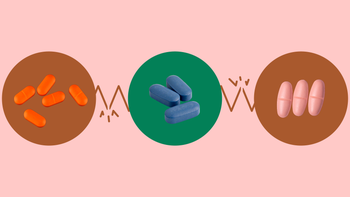
10 Things to Know Before Starting HIV Medications: Side Effects, Benefits, and More
Key takeaways:
It’s best to start HIV medications as soon as possible after diagnosis. Treatment can prevent HIV from growing and spreading, which helps protect your immune system.
A full HIV regimen consists of multiple medications. Most treatment options come as combination tablets. Long-acting injectable options are also available.
HIV medications can cause various side effects, including diarrhea, headache, and tiredness. These tend to improve over time. Other side effects may be less common or limited to specific medications or classes.
Once you start HIV medications, take them exactly as prescribed to avoid HIV drug resistance.
Table of contents
HIV treatment — called antiretroviral therapy (ART) — typically consists of several different medications. HIV medications are recommended for everyone living with HIV. And while ART isn’t a cure, it can help people living with HIV live longer, healthier lives.
If you’re living with HIV, you may have lingering questions about the medications used to treat it. This may include potential benefits, side effects, and what can happen if you stop taking them. We’ll discuss some important points below.
1. It’s best to start HIV medications early
The best time to start ART is as soon as possible after you’ve been diagnosed with HIV. In fact, some studies show that starting ART on the same day as diagnosis can lead to better outcomes. But it’s also important that you feel ready to start treatment, since you’ll be taking ART long term.
The HIV care continuum is important in achieving and maintaining undetectable amounts of HIV in your body. It’s the steps you go through from diagnosis to treatment to follow up. Starting treatment right after diagnosis can help you stay on track and take charge of your care.
But this type of rapid start might not be possible for everyone. Some clinics and health systems aren’t set up for this type of care coordination just yet.
Good to know: Treatment timing is also important if you test positive for HIV while taking pre-exposure prophylaxis (PrEP). PrEP isn’t a complete HIV treatment regimen. So the sooner you transition to ART after your diagnosis, the better.
2. Many HIV medication side effects go away as your body gets used to treatment
There are many different types of HIV medications. And there’s an even larger list of potential side effects that comes with them. The good news is that many of the newer medications have fewer side effects.
Common side effects of HIV treatment include:
Headache
Diarrhea
Tiredness
Feeling sick
You may feel worse when you first start HIV medications. But most of these side effects will go away as your body gets used to them. Let your care team know you’re experiencing these mild side effects, but don’t stop taking your medication.
Many people with HIV live long and meaningful lives: One mother continues to prove this decades after her diagnosis.
How is HIV different for men? HIV symptoms can vary widely, and early signs in men may be mild or easily overlooked. Learn about the most common symptoms, how they progress, and when to get tested for early diagnosis and treatment.
Myths debunked: Misinformation about HIV in the transgender community can create barriers to care. Learn the facts, debunk common myths, and find resources for prevention, testing, and treatment.
Some HIV medication side effects may be less common, or limited to certain medications or classes. Examples of these include:
Sleeping problems, such as vivid dreams or insomnia
Mood changes
Allergic reactions
Liver or kidney problems
Metabolic changes, such as higher cholesterol and blood glucose (sugar) levels
Increased abdominal fat
If you’re concerned about HIV medication side effects, speak with your care team. Many common side effects go away over time. Other side effects may be managed by monitoring your blood work during routine follow-ups. If needed, your regimen may be adjusted or other medications may be added if any side effects become a problem.
3. If you don’t take HIV medication, you’ll have a higher risk of opportunistic infections
HIV is an acronym for human immunodeficiency virus. It’s a virus that attacks your CD4 cells — infection-fighting cells that are part of your immune system. HIV medications work in a variety of ways. But they essentially block HIV from attacking your CD4 immune cells.
Without HIV medications, the virus is able to multiply and can weaken your immune system. This puts you at a higher risk for infection. When there’s severe damage to the immune system, HIV progresses to stage 4 (formerly referred to as AIDS). This puts you at risk for life-threatening opportunistic infections that happen more often in people with weakened immune systems.
4. HIV treatment can help lower your transmission risk and keep your immune system healthy
The goal of HIV treatment is to keep HIV levels low to prevent opportunistic infections and complications. During treatment, your care team will order labs regularly to monitor your health. Two lab values they may review with you on a regular basis are your HIV viral load and CD4 count.
HIV viral load
This number measures how much HIV is in your blood. You want it to be low — ideally undetectable. Undetectable means that the amount of HIV is so low that the lab can’t detect it. But it’s not the same as zero or a cure. And you’ll need to continue HIV treatment in order to keep it undetectable.
Plus, having an undetectable viral load while taking your HIV medications as prescribed means you won’t transmit HIV to someone else through sex. This is referred to as “Undetectable=Untransmittable” or “U=U.”
CD4 count
This number is used to gauge your immune system health. While you want your HIV viral load to be low, you want your CD4 count to go up with treatment. If it’s low — especially below 200 or 250 cells per mcL — you’re at higher risk for opportunistic infections.
5. Take your HIV medication as prescribed to avoid resistance
If you decide to start HIV medications, be sure to take them exactly as prescribed. This helps keep medication levels in your blood consistently high enough to prevent HIV from multiplying in your body.
If you don’t take them as prescribed, this can lead to HIV drug resistance. That’s where HIV is able to keep making copies of itself while you’re taking the HIV medication. Resistance can make treating HIV more difficult in the future because certain medications will no longer work.
There are several reasons why people don’t take their HIV medications as prescribed. Talk to your HIV care team about steps you can take to avoid these common pitfalls:
Not knowing how to take them: Make sure you understand how to take your medications correctly. Keep a medication list with detailed directions.
Forgetting to take them: Set alarms or use a medication reminder app to help you stay on track with your regimen.
Running out of medication early: This may be due to taking more medication than prescribed or sharing your medication with others. It can not only cause you to run out early, but raise the risk of side effects.
Forgetting to refill your medication on time: If you’re having difficulty refilling your medications on time, talk to your pharmacist about automatic refills or refill reminders.
6. Some complete HIV regimens are available as a single tablet
A complete HIV regimen consists of multiple HIV medications. Most of the time, the regimen consists of two or three HIV ARVs from at least two different HIV drug classes. This helps prevent HIV drug resistance.
Fortunately, many HIV medications are now available as combination tablets. This means there are two or three different HIV medications in one tablet. With combination tablets, some people only need to take one tablet once a day.
7. Pills aren’t your only option
Most HIV treatment regimens are available as oral tablets. But as of January 2021, there’s now Cabenuva (cabotegravir / rilpivirine) — the first complete injectable HIV regimen. It’s a long-acting injection that’s given once every 1 to 2 months. It can replace your oral HIV medication if you have an undetectable viral load with your current treatment regimen.
In December 2022, the FDA approved Sunlenca (lenacapavir). It’s a twice-yearly injection that works differently compared to other HIV medications. However, Sunlenca isn’t used by itself, and it’s typically reserved for people who’ve tried other medications without success.
Keep in mind that these injections aren’t options when you’re first starting out. But Cabenuva can be a great future option if you have a well-managed viral load and don’t like taking daily pills. And if you haven’t had success with several other medications, your HIV care team may suggest Sunlenca.
8. HIV medications can interact with other medications you’re taking
HIV medications can interact with a number of other medications. Some of them can cause the HIV medication levels to be too high. This can lead to unwanted side effects. Others can cause levels to be too low, which can lead to HIV drug resistance or HIV that isn’t managed as well.
When should you contact your healthcare team about an interaction with HIV medications?
If you’re concerned about a potential interaction, contact your HIV care team right away. They can let you know if what you’re taking is compatible with your HIV regimen.
Always make sure that your healthcare team has a full list of medications, supplements and over-the-counter products you’re taking ahead of time and after any changes. It’s also a good idea to tell them if you start anything new. Knowing this information helps them plan for any interactions and make sure you’re getting the right amount of medication.
9. There’s no ‘best’ HIV medication
There isn’t a one-size-fits-all HIV medication that’s best for everyone. Instead, experts have created a list of first-choice treatment options. These are the preferred options for most people when they first start treatment.
Still, your HIV care team will review your health history when determining which medications could be a good fit for you. This is typically based on:
HIV drug resistance
Other medical conditions, such as kidney, liver, or bone problems
Potential medication interactions
Medication allergies
Your lifestyle and preferences
Insurance coverage status
10. You’ll need to continue taking HIV medications long term
HIV medications are very effective at lowering the amount of HIV in your body and protecting your immune system. But they’re not a cure. Because of this, you’ll need to continue taking them long term.
Even if your viral load becomes undetectable, you’ll need to continue taking HIV medications to keep it that way. This is the case even if you feel healthy. Be sure to keep up with all of your follow-up appointments to ensure that your current regimen is working for you. Keep in mind that your HIV medication regimen may change over time.
How to save on HIV medications
There are several ways to save on HIV medications. Many are available as brand-name medications, but there are some lower-cost generics available. Manufacturer copay savings cards and patient assistance programs can help make treatment more affordable.
AIDS Service Organizations (ASOs) are also available to provide financial assistance and other services to people living with HIV. Many ASOs receive funding from the Ryan White HIV/AIDs Program (RWHAP), which provides grants to help people receive medical care and afford their medications. You can search for a RWHAP provider near you.
If you’re having difficulty affording your HIV medications, or if you don’t know where you start to get assistance, talk to your healthcare team. They can help you locate and navigate your options.
Frequently asked questions
HIV doesn’t directly change urine color. But you may notice urine color changes due to HIV complications or medication side effects such as kidney damage, liver problems, or infections. Tell your HIV care team if you notice any urine color changes, since it can be a sign of something more serious.
HIV medications can interact with other medications, over-the-counter products, and supplements. These interactions can vary, depending on your HIV regimen. In some cases, certain combinations should be avoided altogether, while others can be managed with close monitoring.
Make sure your HIV care team has your full medication list for review. And check with them before starting any new medications or supplements to make sure they won’t interfere with your HIV treatment.
The bottom line
HIV medications are safe and effective for treating HIV. They can make the amount of virus undetectable in a lab test. But they’re not a cure, and you’ll have to continue taking them to keep it undetectable. Missing doses or avoiding treatment can lead to drug resistance and raise the risk of developing life-threatening infections.
Be sure to discuss your treatment options with your HIV care team so they can find the right medication for you.
Why trust our experts?



References
Boyd, M. A., et al. (2019). Rapid initiation of antiretroviral therapy at HIV diagnosis: Definition, process, knowledge gaps. HIV Medicine.
ClinicalInfo.HIV.gov. (2019). Initiation of antiretroviral therapy.
ClinicalInfo.HIV.gov. (2024). Drug-drug interactions.
ClinicalInfo.HIV.gov. (2024). Tables.
ClinicalInfo.HIV.gov. (2024). What to start.
ClinicalInfo.HIV.gov. (2024). What to start: Initial combination antiretroviral regimens for people with HIV.
Ergin, H. E., et al. (2020). HIV, antiretroviral therapy and metabolic alterations: A review. Cureus.
Gilead. (2022). Sunlenca (lenacapavir) receives FDA approval as a first-in-class, twice-yearly treatment option for people living with multi-drug resistant HIV.
HIV.gov. (2022). HIV care continuum.
HIV.gov. (2023). HIV treatment as prevention.
HIV.gov. (2023). Symptoms of HIV.
HIV.gov. (2023). What are HIV and AIDS?
HIV.gov. (2024). Take charge of your HIV care.
HIVinfo.NIH.gov. (2021). HIV and opportunistic infections, coinfections, and conditions: HIV and kidney disease.
HIVinfo.NIH.gov. (2021). HIV and opportunistic infections, coinfections, and conditions: What is an opportunistic infection?
HIVinfo.NIH.gov. (2021). HIV overview: The HIV life cycle.
HIVinfo.NIH.gov. (2021). HIV treatment: Drug resistance.
HIVinfo.NIH.gov. (2024). HIV overview: FDA-approved HIV medicines.
HIVinfo.NIH.gov. (2024). Side effects of HIV medicines: HIV and hepatotoxicity.
HIVinfo.NIH.gov. (2024). Side effects of HIV medicines: HIV medicines and side effects.
Jones, A. (2018). Side-effects of HIV treatment. Aidsmap.
National Institute of Allergy and Infectious Diseases. (2019). HIV undetectable=untransmittable (U=U), or treatment as prevention. National Institutes of Health.
Perazzo, J. D., et al. (2018). Fatigue symptom management in people living with human immunodeficiency virus. Journal of Hospital and Palliative Nursing.
Ryan White HIV/AIDS Program. (2024). Program parts and initiatives. Health Resources & Services Administration.
U.S. Department of Veterans Affairs. (n.d.). CD4 count (or T-cell count).
U.S. Department of Veterans Affairs. (n.d.). HIV viral load (or 'HIV RNA').
ViiV Healthcare Company. (2024). Cabenuva- cabotegravir and rilpivirine kit [package insert]. DailyMed.
Weinberg, J. L., et al. (2010). The WHO clinical staging system for HIV/AIDS. AMA Journal of Ethics.
Wilberg, M. (2021). Sleep and HIV. Aidsmap.


























